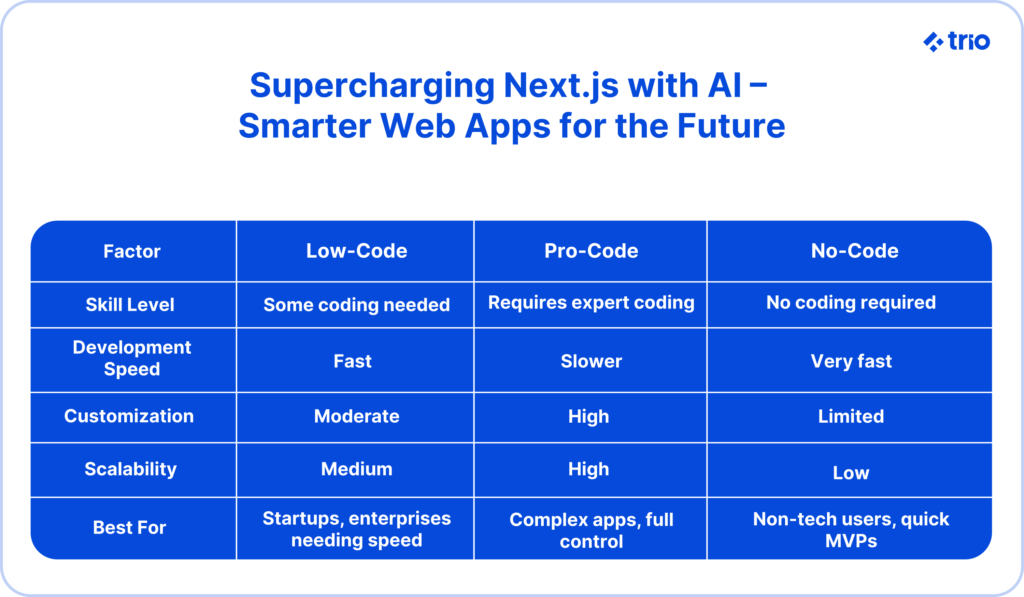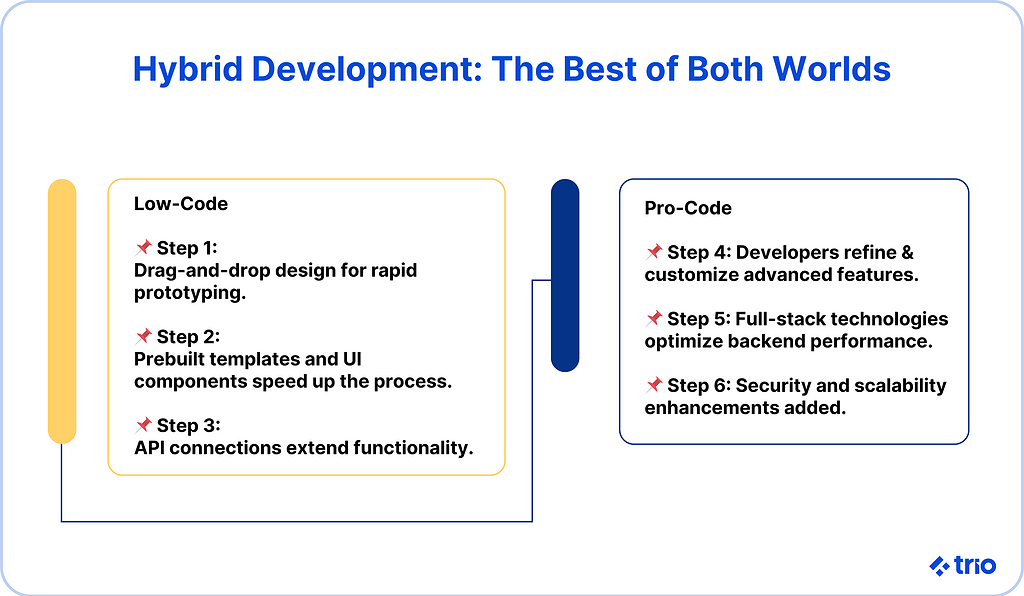Businesses today have a variety of software development tools and technologies at their disposal. One of the key debates associated with application development is the low-code vs. pro-code conundrum.
Should organizations place their trust in the tried and tested traditional development approach or try a more accessible low-code development platform? Perhaps even adopt a completely code-free no-code solution? Should they explore a combination of the two approaches?
The answer, as always, depends on the specific requirements and priorities of the business case in question. You need to explore the pros and cons of low-code, pro-code, and no-code approaches in detail in order to make the right call.
Technology is changing every day, so digital agility and rapid innovation are crucial to your business’s success. Choosing the optimal development strategy impacts competitiveness and efficiency.
If you’re conflicted about choosing the right development approach for your next project, keep reading to learn the differences between low-code, no-code, and pro-code. You might also end up choosing a fourth, hybrid approach that combines the best parts of the two.
If you are unsure, we can offer advice based on the nuances of your project and even provide you with the developers through outsourcing or staff augmentation.
Are you ready to start your development project?
We have the developers you need to take your development project in the right direction.
Companies are proven to grow their business faster with Trio.
Understanding the Coding Approaches
No-Code
No-code, as the name suggests, refers to an approach that does not require you to write any code. Instead, the development approach relies completely on visual tools, drag-and-drop interfaces, and pre-built templates. This is designed for people with no technical background.
Although having no-code can be incredibly inclusive in terms of the fact that it allows more people to create their apps, it is incredibly limiting in many ways. You could only build basic applications, like websites, forms, and workflow automation, and be restricted to the platform’s available components.
Businesses increasingly adopt no-code due to various inherent advantages, especially when rapid prototyping or quick deployment is essential. Key advantages include:
- No programming knowledge is required
- Extremely rapid application development
- Minimal upfront cost and investment
- Quick iterations and modifications
- Empowering business teams to create solutions independently
- Reduced reliance on IT or development teams
However, despite these benefits, no-code development also has distinct disadvantages, especially when projects grow in complexity or require specific custom features:
- Minimal customization capabilities
- Significant constraints on functionality and flexibility
- Less scalability for complex or growing projects
- Limited integration capabilities with external or legacy systems
- Complete reliance on the no-code platform provider, reducing control
Typical use cases of no-code include basic websites, landing pages, simple business workflows, internal forms, surveys, and rapid MVPs (Minimum Viable Products).
Low-Code
Low-code refers to a development approach that leverages an existing infrastructure provided by a development platform. This code scaffolding simply requires the developer to use a drag-and-drop methodology to configure the required application or webpage.

While not requiring manual coding from a developer, low-code development is still different from no-code development, which is a completely code-free approach.
The low-code approach gives you the option to use manual code. However, overall, it encourages accelerated development using the standard artifacts present on the chosen development platform.
Users can always tweak the artifacts to arrive at the custom configuration of choice, but they still have to make do with limited flexibility.
Businesses are making use of low-code development due to several inherent advantages it brings to the traditional development process. Below are some of the pros of opting for low-code development:
- No need to hire extremely skilled developers
- Fast and agile development processes
- Low development costs
- Short time-to-market and high volume of products
- Flexibility to leverage skilled developers to refine the code
- Possible to implement controls and guidelines on the development platform
Low-code development isn’t a magic solution free from drawbacks. While it lends itself well to many business cases, it also isn’t a good fit for others. Some cons of low-code development are as follows:
- Limited feature set and development platforms
- Lack of full-fledged support present in pro-code development
- Less control over aspects like performance and security
- Limited ability to alter the source code
- Larger codebase than pro-code development, as platforms need to account for multiple use cases and application types
Typical use cases of low-code include internal business applications, customer-facing portals, mobile apps with moderate complexity, and legacy system modernization.
Pro-Code?
Pro-code refers to the conventional approach to software development in which professional developers own all aspects of development, such as coding, testing, optimization, and deployment, from start to finish.

Pro-code or traditional development can be visualized as a hierarchical team consisting of technical leads and experienced, cross-skilled developers building applications in accordance with the best coding practices.
This conventional approach can still involve developers leveraging public libraries and frameworks, but the manual effort involved far exceeds the low-code approach.
Developers use popular programming languages like JavaScript, Python, or C++ and associated libraries to build applications and artifacts from scratch. It can take several months, or even years, to become a professional-level coder in even one of these languages.
Pro-code development has more than a few advantages over low-code development, owing to the additional experience and skill of the developers and the added flexibility it provides. Below are some of the pros of pro-code development:
- Easier to build more complex and customized applications
- Better access to the source code, hence easier to fix bugs
- More control over aspects like performance, security, and scalability
- Higher chances of the final output being more polished
- Easier to estimate the time needed to build new features
Pro-code development suffers from some obvious disadvantages as well, many of which can be tracked to the traditional, cumbersome processes it brings. The major cons of pro-code development are as follows:
- Longer development time
- Costly development due to experienced and qualified experts
- Difficult for resources to multi-task due to less agile development
- No pre-built artifacts to leverage, leading to ground-up development
Pro-code development is particularly suitable for highly customized applications, large-scale enterprise software, and projects requiring extensive integration, superior performance, or high security.
Detailed Comparisons: Low vs. Pro vs. No-Code
Development Speed
No-Code is the best option if you are just considering development speed. The pre-built components allow for extremely rapid development times, and you could put together websites in a matter of hours or days. This is one of the many reasons it is popular for prototyping.
Low-code also supports relatively fast and agile development, thanks to the limited manual coding. Pro-code projects take the longest due to all the manual coding, testing, and optimization that needs to occur.
Customization and Flexibility
Customization and flexibility are the inverse of development speed. No-code platforms offer very limited customization as you are limited to the available visual components and predefined configurations. Low-code offers a few more customization options, even if that is just in the form of manual adjustments and tweaks.
Finally, Pro-code development offers maximum flexibility and complete customization. Developers have unrestricted access to source code and are only limited by their creativity, time, and budget.
Required Skill Sets
No-code might come with a small learning curve related to getting familiar with a specific platform, but there are little to no additional technical skills required. This means you might not even have to bring a developer onto your team.
Low-code requires minimal expertise and knowledge of at least the basics of coding principles. Professional developers should be able to carry out advanced customizations without too many issues.
Pro-code requires extensive knowledge and proficiency in a variety of programming languages. JavaScript, CSS, and HTML are the most common requirements for web apps. Your developers will also need to be familiar with the relevant methodologies and frameworks.
Scalability and Maintenance
Scalability and customization tend to go hand in hand. No-code platforms can be difficult to scale because of their restrictive natures, while low-code provides a little more scalability and simpler maintenance through built-in platform upgrades.
Pro-code offers the easiest scaling and maintenance, but you have to stay on top of any issues on your own, as there will be no platform updates keeping you up to date with the most recent regulations and best practices.
Hybrid Development: Combining Low-Code and Pro-Code
Notwithstanding the advantages of either approach, pro-code and low-code development are often used together to yield a better hybrid approach toward development. Even creating low-code platforms requires considerable pro-code development at the back end.
One use case where low-code and pro-code can work in tandem is creating a proof-of-concept using low-code technologies and then entrusting the project to a team of experts to build on top of it to flesh it out into a full-fledged product.
Businesses can get an application up and running by using a low-code platform, leverage the functionality for a limited period of time, and then take a call to bring in expert help or not to scale it further.
Low-code development provides users with ready-to-use artifacts and templates to build standard features, thus saving time and resources, as not everything needs to be built from scratch. Pro-code development can then be used to build the custom and more complex parts of the product.
Many low-code platforms enhance their usability by allowing the application to be connected to pro-code technologies by way of extensions. These platforms use external APIs to connect complex features built with full-stack technologies to the agile low-code core.
Hybrid development is especially advantageous in scenarios like rapid prototyping and legacy application modernization, where low-code platforms are already being used, and pro-code is used to add additional features.
You could also use a hybrid approach in enterprise-scale apps where standardized user interfaces leverage low-code speed while backend integrations and data handling require pro-code sophistication.
Some popular examples we’ve seen include platforms like OutSystems and Mendix, which allow developers to use low-code design tools for visuals, while a pro-code strategy is used to add capabilities. Siemens has used this combination approach, making use of Mendix’s platforms for many apps.


Subscribe to learn more about Hiring
Conclusion
Low-code development extends the ability to build advanced applications and webpages to relatively less technical users, while pro-code development, at least for the near future, remains the better choice for the most complex and large-scale projects.
Key differences include the amount of code that needs to be written. This affects development speed, customization capabilities, te
Organizations can explore a combination of the two approaches to bring the best of both worlds together and gain a competitive advantage.
When selecting the appropriate development approach, you should carefully consider project complexity, available resources, time-to-market requirements, and long-term maintenance capabilities. We can help you with all of that! Reach out to us to set up a call.
Want to put together a great team for your next project?
Trio goes beyond providing exceptional software development insights; we connect you with the best Latin American developers. Discover our elite Argentinean developers, Colombian developers, and Brazilian developers for your outsourcing needs. Contact Trio today to hire qualified developers across technologies.






